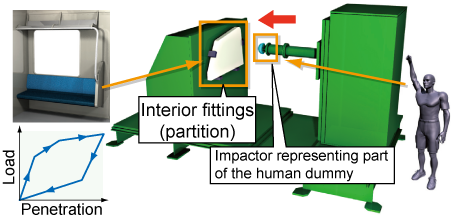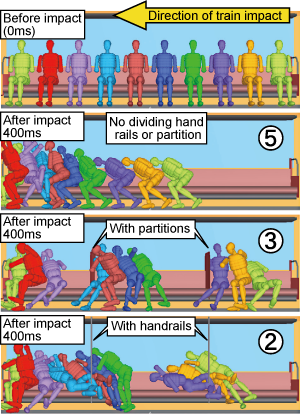1. Simulation of passenger behaviour on board a commuter train in the event of a collision
- A method was developed to simulate passenger behaviour on board a commuter train in the event of a collision.
- By virtue of simulation, key points and countermeasures to improve safety were identified.
In order to gain more insight about survival factors (sources influencing passenger injury) inside a train car in the event of a crash, e.g. a train colliding with a car on a level crossing, a simulation method was developed to reproduce the behavior of passengers seated on bench seats on board a commuter train in a collision. Using Impact Test Equipment (Fig 1) capable of reproducing impacts between human dummy body parts (head, chest) and interior train car fittings (partitions, windows, luggage racks), clearer insight was obtained into passenger body behavior (contact characteristics) in the case of impact, improving the accuracy of the simulation. The simulation method offers the possibility of simultaneously analysing several or more passengers’ behaviour against the impact acceleration in a collision.
Utilizing the abovementioned method to simulate a collision helped to identify key points and possible countermeasures in order to design safer train car bodies from a survival factor perspective.
Given that passengers being thrown together or projected over long distances are a major source of injury, it was deemed that measures aimed at limiting movement in the case of an impact would be most effective. In practical terms, introducing hand rails to divide up the length of a bench seat could reduce injury of seated passengers (Fig 2). Further mitigation of injury could be achieved by incorporating panel-type partitions at the bench ends. These panels would be 1150 mm high for a width of 300 mm, and would reduce injury to both seated passengers and standing passengers located on the other side of the partition. Furthermore, if baggage racks are set at a lower height, then the design can be made more effective by ensuring that the luggage racks are shorter in length to avoid impact with the head of standing passengers.
 Fig. 1 Impact tests with impactor representing the human dummy parts and fittings - example of measurements in the presence of partitions-
Fig. 1 Impact tests with impactor representing the human dummy parts and fittings - example of measurements in the presence of partitions- Fig. 2 Example of analysis of effect of handrails etc introduced on bench seats
Fig. 2 Example of analysis of effect of handrails etc introduced on bench seats
*the number in the circle represents the potential number of chest injury victims